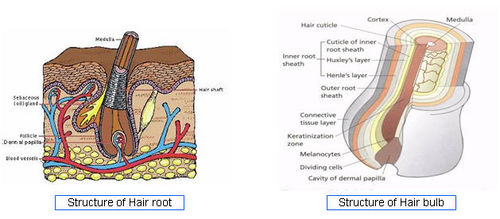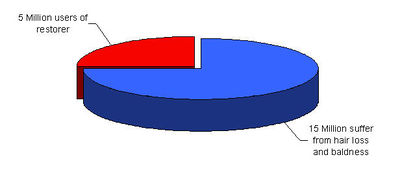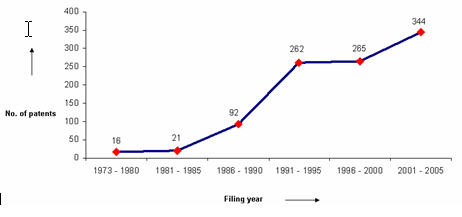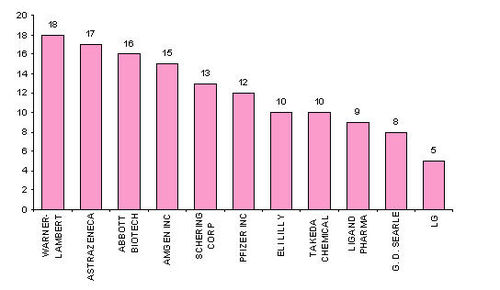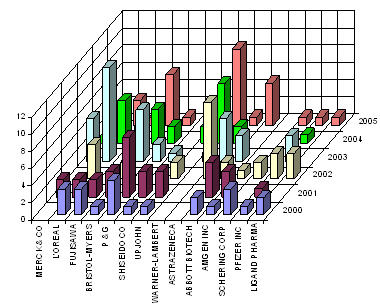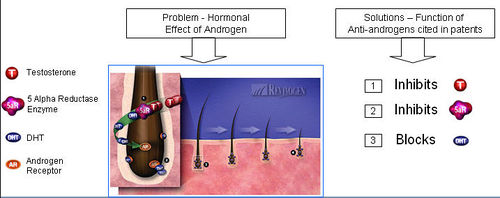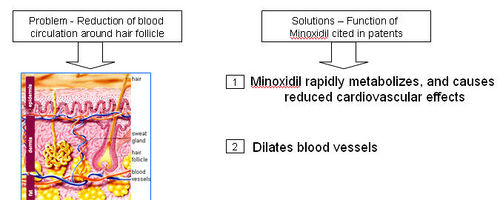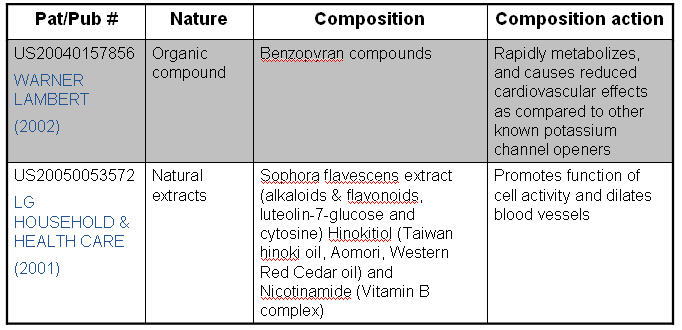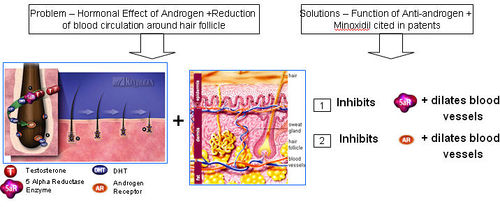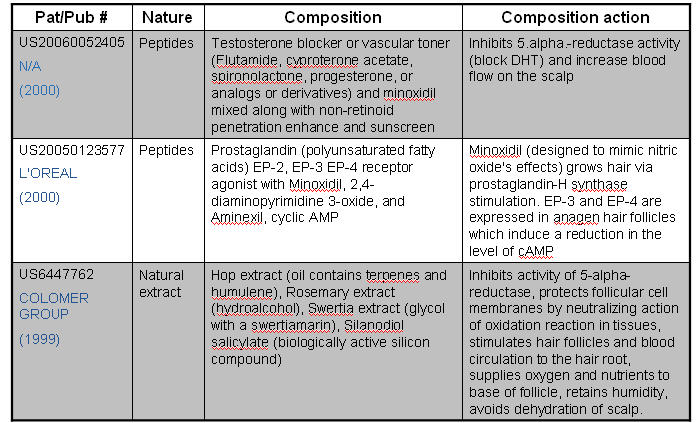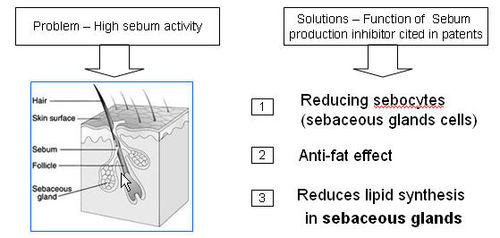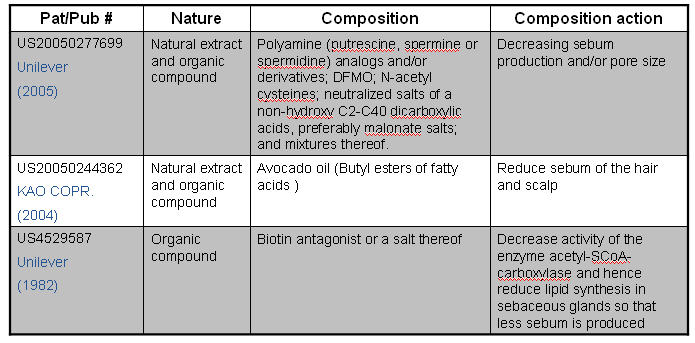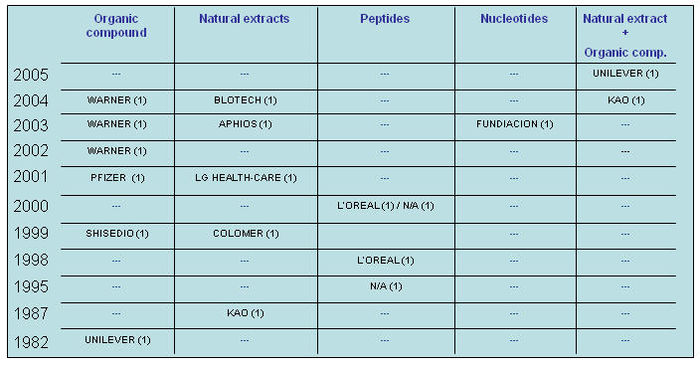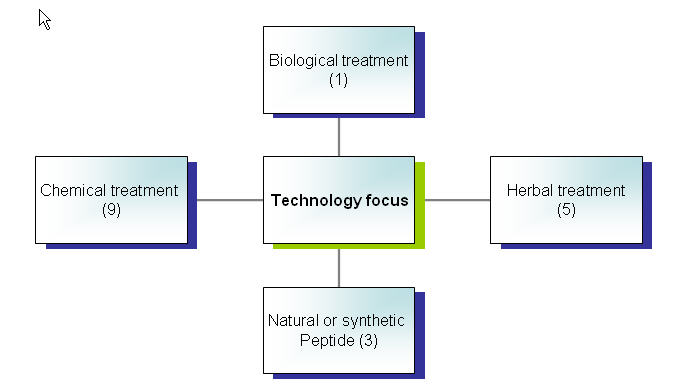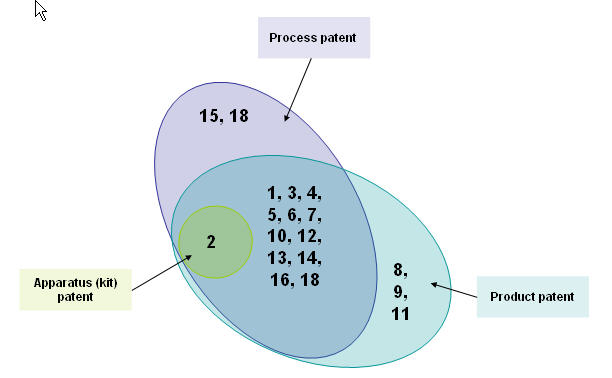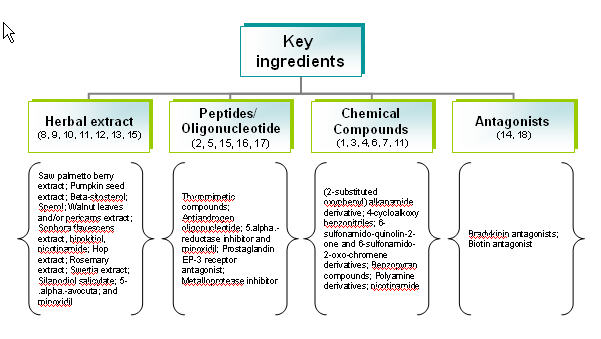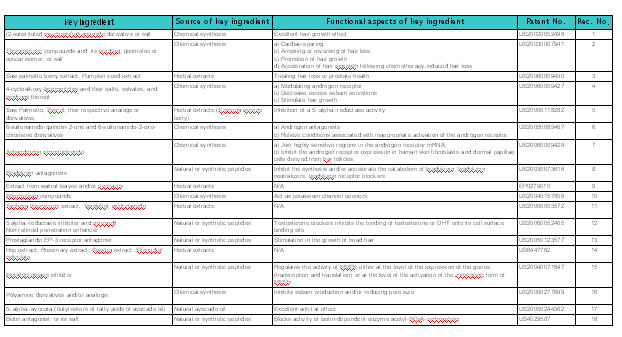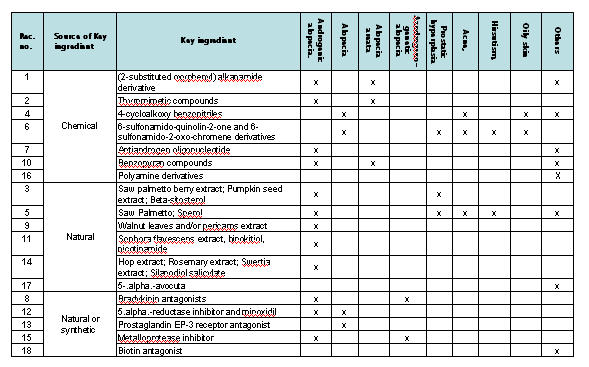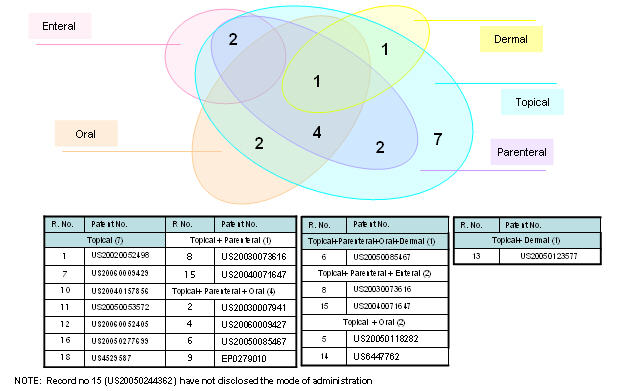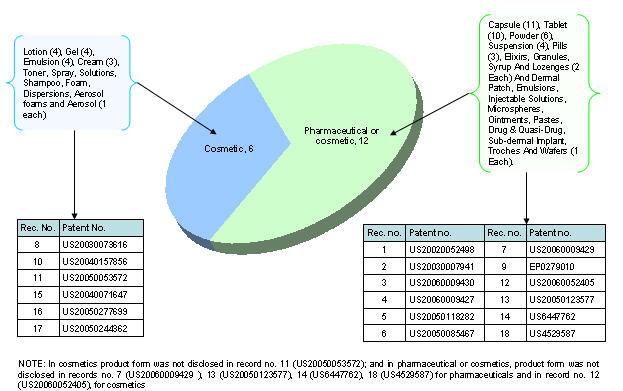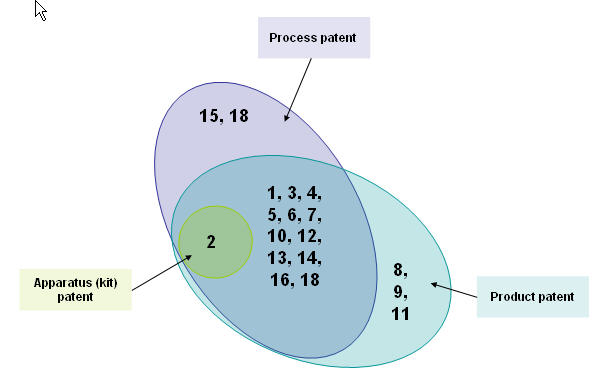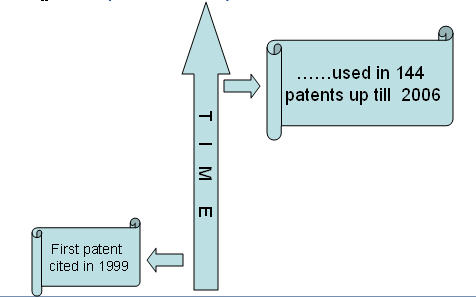Difference between revisions of "Alopecia - Hair Loss"
| Line 105: | Line 105: | ||
!width="300"|Composition | !width="300"|Composition | ||
!width="300"|Composition action | !width="300"|Composition action | ||
| − | |- | + | |- style="height:100px" |
|US20060009430 | |US20060009430 | ||
BLOTECH (2004) | BLOTECH (2004) | ||
| Line 116: | Line 116: | ||
Beta-sitosterol reduce inflammation on scalp | Beta-sitosterol reduce inflammation on scalp | ||
| − | |- | + | |- style="height:100px" |
|US20060009427 | |US20060009427 | ||
WARNER LAMBERT(2004) | WARNER LAMBERT(2004) | ||
| Line 122: | Line 122: | ||
|New class of 4-cycloalkoxy benzonitrile derivatives and salts | |New class of 4-cycloalkoxy benzonitrile derivatives and salts | ||
|Acts as androgen receptor modulators and blocks formation of DHT. | |Acts as androgen receptor modulators and blocks formation of DHT. | ||
| − | |- | + | |- style="height:100px" |
|US20050085467 | |US20050085467 | ||
WARNER LAMBERT(2004) | WARNER LAMBERT(2004) | ||
| Line 128: | Line 128: | ||
|New class of 6-sulfonamido-quinolin-2-one and 6-sulfonamido-2-oxo-chromene derivatives. | |New class of 6-sulfonamido-quinolin-2-one and 6-sulfonamido-2-oxo-chromene derivatives. | ||
|The compounds inhibit, or decrease, activation of androgen receptor by androgens. | |The compounds inhibit, or decrease, activation of androgen receptor by androgens. | ||
| − | |- | + | |- style="height:100px" |
|US20050118282 | |US20050118282 | ||
APHIOS Corp (2003) | APHIOS Corp (2003) | ||
| Line 134: | Line 134: | ||
|Supercritical fluid isolate of Saw Palmetto and Sperol (Serenoa repens berry) and their analogs or derivatives. | |Supercritical fluid isolate of Saw Palmetto and Sperol (Serenoa repens berry) and their analogs or derivatives. | ||
|Modulates androgenic activity by inhibiting 5.alpha.-reductase activity. | |Modulates androgenic activity by inhibiting 5.alpha.-reductase activity. | ||
| − | |- | + | |- style="height:100px" |
|US20060009429 | |US20060009429 | ||
Fundacion Pablo Cassara (2003) | Fundacion Pablo Cassara (2003) | ||
| Line 140: | Line 140: | ||
|Pharmacologically active oligonucleotides (encompass both DNA and S-DNA bond) | |Pharmacologically active oligonucleotides (encompass both DNA and S-DNA bond) | ||
|Oligonucleotides inhibit androgen receptor (AR) expression at very low concentrations in skin and hair follicle | |Oligonucleotides inhibit androgen receptor (AR) expression at very low concentrations in skin and hair follicle | ||
| − | |- | + | |- style="height:100px" |
|US20030007941 | |US20030007941 | ||
PFIZER INC (2001) | PFIZER INC (2001) | ||
| Line 146: | Line 146: | ||
|Thyromimetic compounds (structurally similar to thyronine) with finasteride, or cyproterone acetate | |Thyromimetic compounds (structurally similar to thyronine) with finasteride, or cyproterone acetate | ||
|Activates thyroid hormone receptors in hair follicle which in turn promote elasticisation of follicle walls and hair follicle | |Activates thyroid hormone receptors in hair follicle which in turn promote elasticisation of follicle walls and hair follicle | ||
| − | |- | + | |- style="height:100px" |
|US20030073616 | |US20030073616 | ||
N/A (1995) | N/A (1995) | ||
| Line 152: | Line 152: | ||
|Bradykinin antagonist (peptide of plasma origin from kininogen precursor-kallikrein) | |Bradykinin antagonist (peptide of plasma origin from kininogen precursor-kallikrein) | ||
|Inhibit synthesis of bradykinin receptors or compounds by binding to B2 receptor | |Inhibit synthesis of bradykinin receptors or compounds by binding to B2 receptor | ||
| − | |- | + | |- style="height:100px" |
|EP0279010 | |EP0279010 | ||
KAO Corp (1987) | KAO Corp (1987) | ||
Revision as of 01:18, 28 April 2006
Contents
- 1 Rationale
- 2 Introduction
- 3 Goals
- 4 Approach
- 5 IP activity over years
- 6 Major Players
- 7 Anti-androgens
- 8 Minoxidil
- 9 Double action (Anti-androgen + Minoxidil)
- 10 Hair matrix cell activator
- 11 Sebum Production Inhibitor
- 12 Composition nature matrix
- 13 Focus on different aspects
- 14 Distribution on different aspects
- 15 Distribution of patents based on different aspects
- 16 Questions Dolcera Answers
- 17 New Combinations based on IP study?
- 18 IP studies provides
- 19 Conclusions
- 20 Useful links
Rationale
- “Medication for men plagued by hair loss has become a topic of interest in Japan since a drug company began marketing it at the end of last year." March 5th, 2006 – [1]
- “An increasing number of companies are apparently turning the Chinese fear of a bald spot into big bucks with some doing so well they are branching out into other countries.” February 16, 2006 – [2]
Introduction
Hair Basics
- Hair is a complex and delicate part of the body
- Keeping it healthy and beautiful is a challenge
- Structure of Hair root - [3]
- Structure of Hair bulb - [4]
Reasons for Hair loss
Both men and women lose hair for similar reasons. Hair loss in men is often more dramatic, and follows a specific pattern of loss which has been termed “Male Pattern Baldness” (Androgenetic Alopecia).
Main reasons
- Hormonal effect of androgen
- Reduction of blood circulation around hair follicle
- Deactivation of hair matrix cells
Some facts from Japan
- Market size: ¥ 30 Billion
- Number of products: more than 100
(JICST-EPlus - Japanese Science & Technology)
Goals
- Summarize IP activity over the years
- Identify major players
- Conduct patent analysis
a) Composition b) Nature c) Action
Alopecia occurs due to
- Hormonal effects of androgens
- Reduction of blood circulation around hair follicle
- Deactivation of hair matrix cells
And then
- Analyze patents pertaining to high sebum activity
Approach
Broad search conducted on hair loss patents.
Patent information sourced through SIP.
Patents selected randomly for analysis.
Composition of treatment for causes are identified and categorized as follows:
- Anti-androgen
- Minoxidil
- Double action (Anti-androgen + Mindoxidil)
- Hair matrix cells activator
- Sebum production inhibitor
IP activity over years
The graph indicates: -
- Number of patents filed every 5 years (except for first 7 years).
- First solution proposed in 1973
- Filing trend indicates steep rise in activity recently.
Major Players
- Assignees with more than 20 patents to their credit
- Assignees with less than 20 patents to their credit
- Active Assignees
Assignees currently active with more than 5 patents to their credit during 2000-2005, among them following are the leaders of 2005-
WARNER with 9 patents,
BRISTOL with 6 and
ABBOTT with 5.
Anti-androgens
- Anti-androgen is a substance that inhibits biological effects of androgenic hormones
- 5-alpha reductase + Testosterone = Dihydrotestosterone (DHT)
- DHT attaches to an Androgen Receptor.
- DHT causes increase in hair loss and gradual miniaturization of the follicle, which eventually dies resulting hair loss
